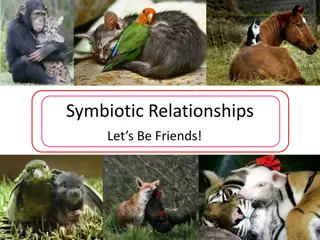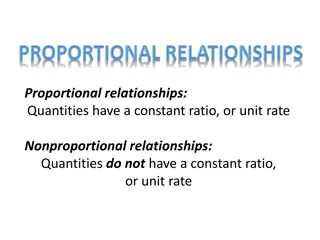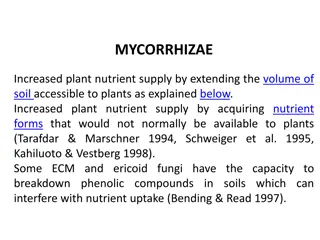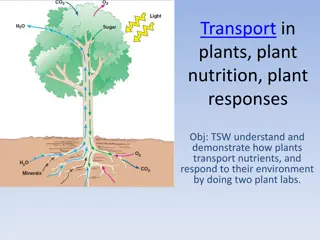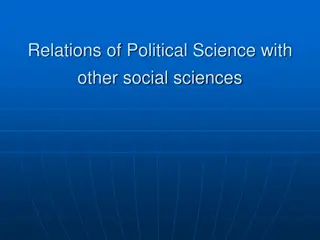Importance of Relationships in Professional Learning Framework
Relationships are crucial for the wellbeing, learning, and behavior of Scotland's learners. This resource, designed by @ESInclusionTeam, emphasizes the significance of fostering strong, trusting relationships between educators and learners. It provides slides for facilitating professional learning s
4 views • 21 slides
Understanding Symbiotic Relationships in Nature
Symbiotic relationships are close interactions between different species, where each member benefits in various ways. Examples include mutualism, where both organisms benefit, and commensalism, where one benefits without harming the other. Ectosymbiosis and endosymbiosis describe how organisms live
0 views • 17 slides
Explore Symbiotic Relationships in Nature
Understand symbiosis through examples like mutualism, commensalism, and parasitism. Discover unique partnerships like the Acacia Tree and Ants, Boxer Crab and Anemone, and more. Learn how different species benefit from living together in nature.
0 views • 17 slides
Understanding Symbiotic Relationships in Marine Life
Symbiotic relationships in marine life showcase diverse interactions where different species benefit from each other. Mutualism, such as the bond between Clownfish and Anemones, and the partnership between Goby Fish and Shrimp, exemplify how cooperation ensures survival. Additionally, the collaborat
2 views • 15 slides
Understanding Nitrogen Fixation Process in Plants
Nitrogen fixation is the conversion of atmospheric nitrogen into ammonia or nitrates by bacteria or industrial processes for plant absorption. Biological and abiological methods exist, with various bacteria and cyanobacteria involved in the process. Symbiotic relationships between these organisms an
1 views • 10 slides
Understanding Symbiotic Relationships in Nature
Symbiotic relationships are intricate connections between different species where they benefit from each other. Mutualism, commensalism, and parasitism showcase the diverse ways organisms interact. Examples like decorator crabs with sponges, proboscis butterflies with flowers, and barnacles on whale
1 views • 22 slides
Understanding Proportional and Nonproportional Relationships in Mathematics
Proportional relationships involve quantities having a constant ratio or unit rate, while nonproportional relationships lack this constant ratio. By examining examples such as earnings from babysitting and costs of movie rentals, we can grasp the differences between these two types of relationships.
2 views • 6 slides
Understanding Relationships in Business: Stakeholders, Dynamics, and Cooperation
Exploring the intricate web of relationships in business, this content delves into the dynamics between stakeholders such as workers, managers, entrepreneurs, investors, and customers. It discusses the nuances of cooperative and competitive relationships, dependent relationships, and dynamic interac
0 views • 23 slides
Exploring Symbiotic Relationships in Missouri Forest Ecosystems
Delve into the intricate web of cooperative interrelationships within Missouri forests, where diverse communities coexist in a delicate balance. Discover the concept of ecosystems, from deserts to lakes, and learn about symbiosis through examples of parasitism and commensalism. Explore the fascinati
0 views • 18 slides
Fascinating World of Lichens: Insights into a Unique Symbiotic Relationship
Lichens are intriguing dual organisms composed of algae and fungi, forming a symbiotic relationship with fascinating adaptations. They serve as environmental indicators, thriving in diverse habitats worldwide. Learn about their distribution, occurrence, composition, and general characteristics in th
0 views • 46 slides
Understanding Mycorrhiza: Types, Importance, and Classification
Mycorrhiza is a symbiotic association between fungi and plant roots crucial for plant survival. Around 95% of plant species form mycorrhizal relationships, with mycorrhizae existing since the earliest land plants. Classification includes Ectomycorrhiza and Endomycorrhiza based on tropic levels. Ecto
0 views • 21 slides
Nitrogen Fixation and Symbiotic Relationship in Agriculture
Nitrogen fixation is a crucial process where nitrogen is converted into ammonia by nitrogen-fixing bacteria, benefiting plants like legumes. Symbiotic nitrogen fixation involves a mutualistic exchange between plants and bacteria, exemplified by Rhizobium species. This symbiosis leads to the conversi
0 views • 15 slides
Benefits of Mycorrhizae in Plant Nutrition and Ecosystem Health
Mycorrhizae play a crucial role in enhancing plant nutrient uptake, protecting against pests, improving plant growth, and fostering ecosystem stability. These symbiotic relationships provide various benefits such as increased nutrient supply, protection from pathogens, enhancement of plant growth fo
0 views • 9 slides
Understanding Lichens: A Symbiotic Organism in Nature
Lichens, a unique symbiotic organism combining a fungus and alga or cyanobacterium, are widely distributed and diverse in nature. Comprising of 186 plant species from 148 genera and 63 families, lichens are versatile in their adaptation to different habitats and substrates. This article delves into
0 views • 21 slides
Understanding Ecology: Interactions in Ecosystems
Explore the intricate web of interactions in ecosystems through the study of ecology. Learn how biotic and abiotic factors shape ecosystems, trace energy flow, and understand nutrient cycles. Discover the importance of biodiversity and the impact of human activities on the biosphere. Dive into topic
0 views • 51 slides
Pros and Cons of Crustaceans: A Detailed Overview
This detailed overview explores the pros and cons of various crustaceans, including Branchiopoda, Canthaxanthin, Remipedia, Cephalocarida, and Maxillopoda. From the potential to be kept as pets to symbiotic relationships and challenges like water flea infestation and venomous species, this content p
0 views • 21 slides
Understanding Community Interactions and Symbiosis in Ecology
Explore the dynamics of community interactions, including competition and symbiosis, in ecological systems. Learn about mutualism, parasitism, and commensalism as examples of symbiotic relationships within ecosystems. Understand the implications of the competitive exclusion principle and how species
0 views • 10 slides
Exploring the Ecology of Finding Nemo and the Great Barrier Reef
Delve into the fascinating world of "Finding Nemo" as it intertwines with the rich ecosystem of the Great Barrier Reef. Discover the challenges faced by marine life, from clownfish hiding in anemones to symbiotic relationships among different species. Learn about conservation issues like pollution,
0 views • 5 slides
Understanding Nutrition in Plants and Their Relationship with the Environment
This educational content delves into the various modes of nutrition in plants, including heterotrophic and autotrophic nutrition, as well as saprotrophic and parasitic nutrition. It explains the process of photosynthesis, absorption of water through roots, oxygen production, and symbiotic relationsh
0 views • 13 slides
Understanding E/R Model Considerations and Relationships
Explore the E/R model considerations and relationships like multiplicity, multi-way, conversion to SQL, and more. Learn about modeling purchase relationships and the significance of arrows in multi-way relationships. Understand the challenges in expressing constraints like every person shopping at m
0 views • 29 slides
Ecology Test Review Questions and Answers
Test your ecological knowledge with these questions covering topics like organism interdependence, symbiotic relationships, energy flow in ecosystems, and more. Explore concepts of commensalism, mutualism, and parasitism while learning about the roles of different organisms in maintaining ecosystem
0 views • 30 slides
Understanding Plant Transport, Nutrition, and Responses
The process of how plants transport nutrients and respond to their environment is demonstrated through labs focusing on protein transport, water absorption by roots, and control of transpiration using mechanisms like diffusion, osmosis, and symbiotic relationships with fungi. Various components in p
0 views • 28 slides
Classification of Algae, Economic, and Ecological Significance, Bryophytes Overview
Algae, classified into green, brown, and red types, play crucial roles in food, industry, and ecology. Green algae are significant in symbiotic relationships, while red and brown algae provide commercial products. Algae are vital producers in aquatic ecosystems, contributing to ecological balance. B
0 views • 18 slides
Morphology and Adaptations of Gymnosperms
Explore the characteristics of gymnosperms, including their arborescent sporophyte structure, xerophytic adaptations, and symbiotic relationships with roots and fungi. Learn about the unique features such as the taproot system, vascular cylinder composition, and diverse examples like Taxodium sp. an
0 views • 23 slides
Comprehensive Relationships, Sex, and Health Education Syllabus Presentation
This syllabus presentation covers six main areas including relationships, consent, human sexuality, online safety, and sex education. It aims to educate students on understanding healthy relationships, consent in all types of relationships, human sexuality, online safety, and sex education facts and
0 views • 12 slides
The Importance of Effective Communication in Healthy Relationships
This module from the Welcoming Warriors Home Manual focuses on helping veterans understand healthy relationships and effective communication skills to nurture positive connections with their partners. It addresses conflict resolution, cultivating healthy relationships, repairing relationships after
0 views • 11 slides
Understanding Symbiotic Relationships in Nature
Explore the fascinating world of symbiosis through various examples like the partnership between a Nile crocodile and a crocodile bird, the mutual benefit of a buffalo and an oxpecker bird, and the intricate connection between a hermit crab and a sea anemone. Discover how different species coexist a
0 views • 15 slides
Understanding the Role of Soil Biology in Lawn Care
Soil biology plays a crucial role in maintaining healthy and vibrant lawns. Various organisms, including invertebrates, plant roots, mycorrhizae, and micro-organisms, contribute to functions such as soil structure maintenance, regulation of soil hydrological processes, gas exchange, carbon sequestra
0 views • 27 slides
Understanding and Promoting Healthy Youth Relationships for Preventing Domestic Violence
Creating transformational change through primary prevention strategies is crucial to ending domestic violence. The SHIFT project focuses on stopping first-time victimization and perpetration by promoting healthy relationships, families, and communities. Initiatives like The Fourth R: Healthy Relatio
0 views • 29 slides
Exploring the Diverse World of Proteobacteria
Proteobacteria, a phylum of Gram-negative bacteria, exhibit wide morphological and metabolic diversity with clinical, environmental, and industrial relevance. This phylum, boasting the highest number of cultured representatives, is divided into various groups based on 16S rRNA sequencing. From N2-fi
0 views • 49 slides
Understanding Population Interactions in Communities
Communities are made up of populations of organisms that interact in various ways, shaping the structure of the community. Population interactions include predator-prey relationships, symbiotic interactions like mutualism and commensalism, parasitism, and competitive exclusion. These interactions in
0 views • 25 slides
Understanding Parasitology in Veterinary Medicine by Prof. Dr. Suzan A. Al-azizz
Parasitology is a vital study of parasites and their hosts, encompassing various disciplines like cell biology, bioinformatics, genetics, and ecology. This field emphasizes the binomial system of species naming pioneered by Linnaeus. The essence of human scientific naming is exemplified by Homo sapi
0 views • 16 slides
Understanding Symbiotic Relationships in Nature
Symbiosis is the act of organisms living together, benefiting each other or having one organism harmed while the other benefits or remains unaffected. It includes mutualism, parasitism, and commensalism, each showcasing different types of interactions in nature. Examples such as flowers and insects
0 views • 12 slides
The Symbiotic Relationship Between Humans and the Earth
Earth and human beings share a unique and symbiotic relationship. As human activities increasingly impact the planet's ecosystems, environmental changes have become prominent, posing threats to sustainability. Discussing global environmental issues involves complexities in science, stakeholder coord
0 views • 15 slides
Exploring the Interconnected World of Owls and Larvae through Earth Science
Discover the intricate relationships between owls, larvae, and their ecosystems in this compelling Earth Science portfolio project by Alexis. Learn about food chains, cellular respiration, endangerment factors, and symbiotic relationships. Gain insights into the role of decomposers, environmental im
0 views • 11 slides
Understanding Microsoft Enterprise Consortium Database Relationships
Explore the fundamentals of data models, relationships, and cardinality in the Microsoft Enterprise Consortium Database. Learn about entities, attributes, identifiers, and the different types of relationships like one-to-many, many-to-many, and one-to-one. Gain insights into the degree of relationsh
0 views • 10 slides
Interdisciplinary Relationships in Political Science
Political science and history share a symbiotic relationship, with history providing the foundation for political analysis while political science influences historical events. The contribution of economics to political science is evident in how economic conditions shape political ideologies and pol
0 views • 12 slides
Understanding AS Relationships in Internet Routing
Exploring the complex ecosystem of AS relationships in Internet routing, the CAIDA's AS-rank project measures the influence of ASes through customer cones and validates the relationships for accuracy. The ground truth summary provides insights into the types and distribution of AS relationships, hig
0 views • 14 slides
Understanding Allelopathy: Chemical Interactions Among Plants
Allelopathy involves the chemical inhibition of one plant species by another, affecting growth and development. Target species may suffer from reduced growth, nutrient uptake, and disrupted symbiotic relationships due to allelopathic chemicals present in different plant parts and soil. Certain plant
0 views • 4 slides
Understanding One-to-One and Recursive Relationships in Data Modeling
Explore the concepts of one-to-one and recursive relationships in data modeling through images and explanations. Learn about labeling relationships, mapping foreign keys, and creating tables in MySQL Workbench. Dive into examples showcasing 1:1 relationships and recursive relationships, with insight
0 views • 43 slides





